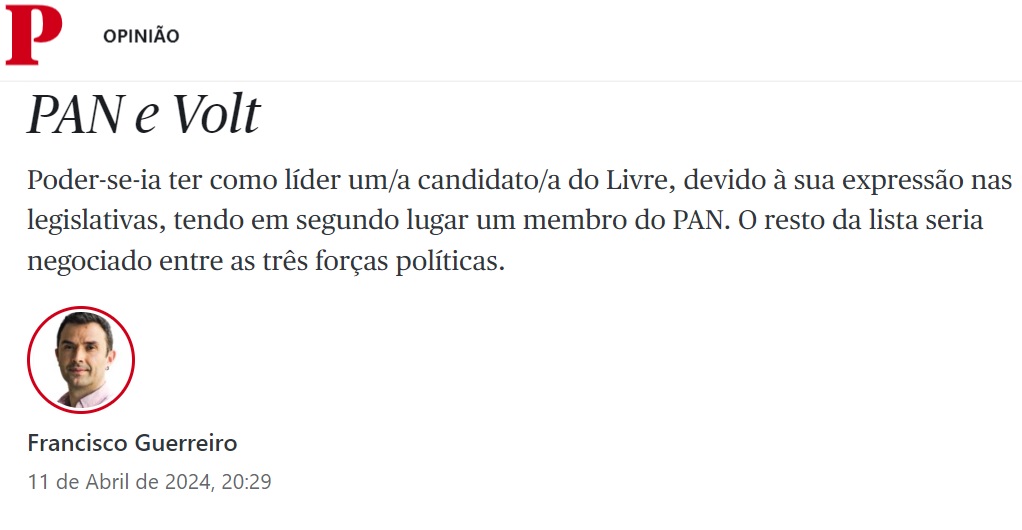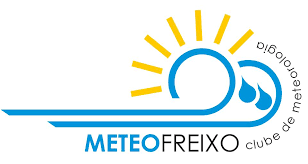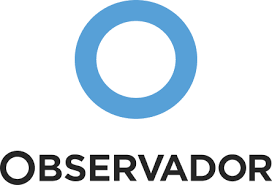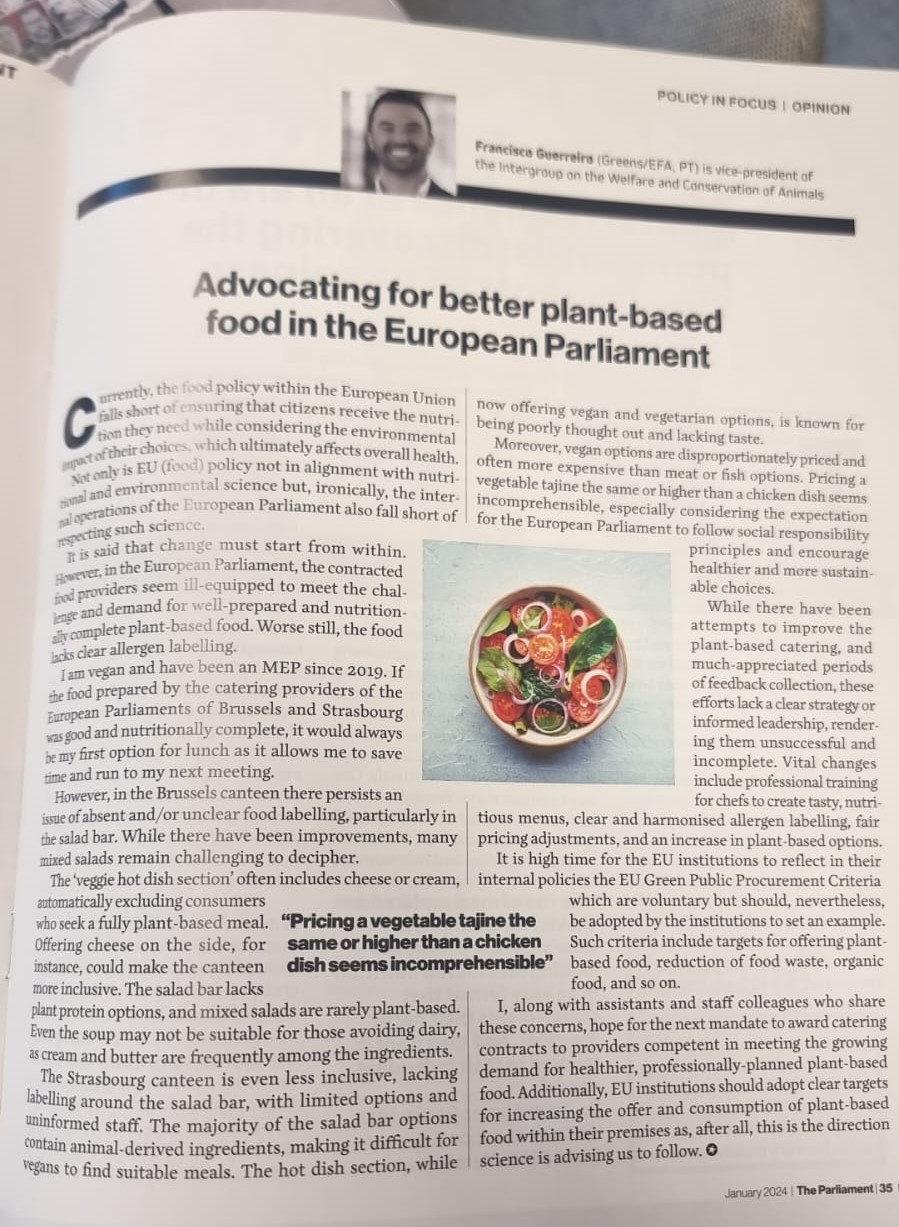
The Parliament Magazine: 'High steaks: how cultivated meat could transform our food systems'
Cultivated meat offers people the taste they enjoy without the need to slaughter animals. But does the EU see this lab-grown alternative as a mouthwatering prospect? Sarah Schug reports
ast summer, Michelin-starred Dominique Crenn made history when she served cultivated chicken – poultry engineered from cells in a laboratory – at her San Francisco eatery, Bar Crenn. Having taken meat off the menu in 2018 due to animal welfare and environmental considerations, the French chef’s restaurant was the first in the United States to create a dish with cultivated chicken, and only the second location worldwide to offer the food at all.
“It sears, smells, cuts and chews like meat,” she said of the product manufactured by American startup Upside Foods, which she serves fried alongside a burnt chili aioli, edible flowers and greens. Days later, celebrated chef José Andrés followed suit in Washington DC at his restaurant, China Chilcano, presenting chicken cultivated by Californian company Good Meat marinated in anticucho sauce, accompanied by potatoes and chimichurri.
The launches generated media attention and were widely perceived as a landmark moment. “People are responding really well to it. They say it tastes like chicken, and want us to increase production, and that’s what we have to do,” says Josh Tetrick, CEO of Good Meat.
But what exactly is this futuristic creation, also known as cultured, lab-grown, or cell-based meat? The making of cultivated meat – the term industry consensus has landed on – starts with cells collected from an animal, that are then placed inside a stainless-steel tank. This bioreactor is filled with a nutrient-rich liquid allowing the cells to multiply. Exactly which cells are used as well as the make-up of the growth solution varies between producers. After several weeks, the meat is ready to be harvested. The process is often compared to brewing beer.
All over the globe, about 150 startups in 26 countries are currently working on replicating meat in laboratories. In 2020, Good Meat achieved a significant a milestone when it launched its cultivated chicken nuggets in Huber’s Butchery and Bistro in Singapore, becoming the very first in the world to bring lab-grown meat to the market. The country was an obvious choice, as its food agency was the first ever to approve a cultivated meat product for general consumption.
It sears, smells, cuts and chews like meat
Here in Europe, however, consumers don’t currently have the option to taste these cutting-edge products, despite it being the birthplace of cultivated meat. In 2013, Mark Post, a researcher at Maastricht University in the Netherlands, presented the first cultivated meat creation at a press conference in London – a beef burger patty built from more than 20,000 thin strands of muscle tissues, whose engineering cost a whopping $325,000 (in the region of €244,000).
It comes as no surprise, then, that the Netherlands is a European hotspot for cultured meat research. In 2022, the Dutch government decided to dedicate €60m to the sector to support the formation of an ecosystem around cellular agriculture. Accordingly, the country is a fruitful breeding ground for leading startups such as Mosa Meat and Meatable, together with universities doing research in the field. Plus, the Netherlands is the first country in Europe to authorise the consumption of lab-grown meat and seafood, albeit in controlled environments like a test lab.
In other European countries, the situation is far different. Take Italy; in November, the parliament passed a law banning the production, sale and import of cultivated meat – the first country in the world to do so. The reasoning: defending Italian food culture and heritage, paired with warnings of synthetic food items. Romania has started a similar process, pointing to the protection of its local traditional meat sector.
At the same time, the European Commission is funding the industry, administering grants amounting to millions to startups such as Meatable, Mosa Meat, and the Icelandic ORF Genetics, for instance. In a European Commission expert report, meat alternatives such as cultivated meat were identified as an important part of implementing its Food 2030 Initiative which aims to establish a sustainable food system for Europe.
All funding aside, a company has yet to submit an application for approval of a cultivated meat product at the European Food Safety Authority (EFSA). The blatant disparity between Member States is not the only obstacle. The EU is also known for its meticulous, but lengthy, approval processes – something that can scare off highly competitive startups eager to launch and test their products as quickly as possible.
“It’s a bit too long and too complicated. There are lots of things that other regulators do better, whether it’s guidance for companies or pre-submission consultations where they talk about how to get approved,” says Seth Roberts, policy manager at the Good Food Institute, a non-profit think tank promoting plant and cell-based meat alternatives. “They do not see themselves as the gatekeeper, but as a collaborative force that supports innovation.”
Tetrick’s experiences when attempting to launch an egg alternative on the Continent mirror this view. “There needs to be more of a balance to allow innovation to flourish. It took two years for us to get approvals for our mung bean protein while, in the United States, no approval was needed at all.”
Even if EFSA deems a product safe for consumption, it doesn’t end there. In line with the Novel Food Regulation “you also need the green light from the political institutions”, explains Portuguese MEP Francisco Guerreiro (Greens/EFA), who believes the upcoming European elections will play a decisive role in that context. “It all depends if the next mandate will be more conservative.”
That startups are submitting applications in European countries such as the United Kingdom and Switzerland but not in the EU, and that French company Vital Meats started the approval process in Singapore instead of on home turf, are all worrying signs. “Something is wrong there. Europe needs to start giving consistent signals to the sector,” warns Roberts.
Europe needs to start giving consistent signals to the sector
If the bloc doesn’t act quickly, it might fall behind in what could potentially become a food revolution. “Businesses need certainty and confidence when they’re looking to approach regulatory authorisation. In Singapore, there’s a really clear path to market,” Roberts adds.
Over the years, almost $3bn (€2.74bn) worldwide have been invested in the industry. While the roadblock of getting regulatory approval has already been overcome for several companies in different countries – the approval of products by both Upside Foods and Good Meat by the United States Food and Drug Administration last June signified a major breakthrough – it still seems to be a long way from being widely available in restaurants and on supermarket shelves.
So what’s the hold-up? Simply put, the production process is extremely costly and time-consuming. For example, yeast can expand well over 1,000 times in less than a day, whereas it takes more than 10 days for animal cells, according to Lieven Thorrez, head of the tissue engineering Lab at KU Leuven in Belgium. Plus, “the growth media is very expensive, and can cost several hundred dollars per litre”, he points out. Building sophisticated manufacturing facilities is not cheap, either.
Thorrez advises taking claims of scientific breakthroughs by startups with a pinch of salt. “There are too many problems with the scientific process. With the current technology that I am aware of, it is not possible to create muscle tissue that’s completely identical in nutrients and texture with that coming from an adult animal.” Another problem is the size of the bioengineered tissues, which are extremely small and have to be combined to make a single piece.
The fact that so few of the 150 startups actually submit a finished product to the authorities seems to confirm this perspective. When asked about scaling up, Tetrick responds: “We have the approval in two markets with a combined population of 350 million people. Yet we only have the capacity to serve in the hundreds. So getting more regulatory approvals, although I want them, is not the key step to making this happen. The key is to build the infrastructure and develop the processes that enable us to make more at a much lower cost.”
Interestingly, since Good Meat started, the company has produced less than 5,000lbs (about 2,268kg) of meat in total. To put it into perspective, EU citizens eat around 69kg of meat per capita each year.
Still, Tetrick remains confident: “Many technologies in the past were this capital-intensive before they developed a more efficient way.”
Where does his drive come from? “The primary reason I’'m doing this is that we do not need to harm animals in order to enjoy food. And cultivating meat is a way of meeting people where they are,” he explains.
Indeed, the innovative food is more tailored towards meat- eaters than those who already follow a vegan or vegetarian diet. Camilla Björkbom, political adviser for food policy at the Eurogroup for Animals in Brussels, explains: “Vegan and vegetarians are usually fine with plant-based products. Cultivated meat is an alternative for those who want real meat but want to eat more sustainably, or are not that comfortable with animal slaughter. We see it as a puzzle piece for a system transition towards plant-based diets, which needs to happen, for the planet, and for the animals.”
If it is safe to consume, then this has the potential to revolutionise the food system
While Tetrick, who has been vegan for a long time, has no reservations about biting into a cultivated chicken burger, and animal welfare groups generally applaud the initiative due to its potential to reduce large-scale factory-farming, not everyone in the vegan and vegetarian community is convinced.
Guerreiro, who follows a vegan diet, would refrain from eating it, despite welcoming the idea of cultivated meat. “It comes from living animals, and so I would be exploiting them, but that’s a personal decision. If it is safe to consume, then this has the potential to revolutionise the food system.”
Compared to the widely documented horrific conditions of industrial farming, the impact of cultivated meat production on animals is much smaller. Björkbom confirms that the biopsies necessary to derive the cells needed for the production process are not harmful or invasive. “But as this scales up it’s also important that there will be guidelines for how these animals are kept, how often can you take a biopsy from the same animal, and so on,”, she says.
This hasn’t always been the case. Originally, the so-called foetal bovine serum, which is made by harvesting blood from the bovine foetus after it has been removed from the slaughtered cow, was the only liquid allowing the collected cells to healthily survive, grow and divide.
“It was sort of an anomaly that was the case in the early stages. But now, companies like ours have solved the technical issues required to remove it,” says Tetrick. “They are all slowly moving away from it,” Björkbom confirms.
If produced on a large scale, not as a luxury item but as cheap, or cheaper, than conventional meat, fewer animals would fall victim to industrial farming – currently 80 billion are slaughtered for food per year. But improved animal welfare is not the only prospective benefit. A reduction in industrial farming would also free up land, according to a report by the Food and Agriculture Organisation (FAO). Additionally, cultivated meat is free from antibiotics and pathogens such as salmonella, a fact that makes it healthier for humans to consume and could help mitigating the growing problem of antibiotic resistance.
Lê o arttigo aqui










Tejo FM - Integridade + Episódio: 15 Francisco Guerreiro
Segunda-feira, 15 de Julho de 2024
LER MAIS